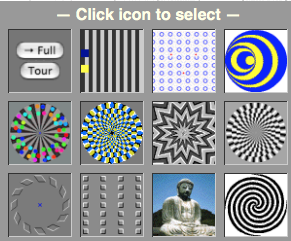Optical illusions can be found in many different places on the web. They can also be found on the online pages of well-known magazines. Here I concentrate on collections dealing with thematic compilations of optical illusions.
- Wikipedia provides a compact presentation of basic features, illustrated by concrete (picture) examples. This is a good introduction.
- In my opinion, the best page on the net about optical il
 lusions can be found at Michael Bach. He is a professor of vision and eye research. For some years now he has been running his own website for which he has collected optical illusions and edited them interactively. As a scientist he also explains how they work: michaelbach.de/ot/
lusions can be found at Michael Bach. He is a professor of vision and eye research. For some years now he has been running his own website for which he has collected optical illusions and edited them interactively. As a scientist he also explains how they work: michaelbach.de/ot/ - In several countries there are museums for optical illusions in which the illusions can be experienced in a playful way. Only a selection: Museum der Illusionen (Berlin), Museum of Illusions (New York), Camera Obscura (Edinburgh). Some museums are located quite unexpectedly away from the metropolises, like e.g.
 Lingelbachs Scheune, the Museum of Optical Phenomena. On the website you will find an extensive catalogue with background information on many illusions.
Lingelbachs Scheune, the Museum of Optical Phenomena. On the website you will find an extensive catalogue with background information on many illusions. - A real treasure trove is the page Illusion of the Year
 Contest. In this annual contest, new illusions are always submitted, judged and awarded by a jury. In the archive you will find all contributions from 2005 onwards and scientific articles on selected illusions. The book Champions of Illusion presents several examples and provides background information.
Contest. In this annual contest, new illusions are always submitted, judged and awarded by a jury. In the archive you will find all contributions from 2005 onwards and scientific articles on selected illusions. The book Champions of Illusion presents several examples and provides background information. - The Centre for the Study of Perceptual Experience at the University of Glasgow curates The Illusions Index. In
 all examples, sorted by thematic areas (size, form, perspective, etc.), philosophical and perceptual psychological information is provided.
all examples, sorted by thematic areas (size, form, perspective, etc.), philosophical and perceptual psychological information is provided.  The Japanese psychology professor Akiyoshi Kitaoka from Ritsumeikan University in Kyoto is constantly developing new illusions. The best known is his movement illusion Rotating Snakes, which he described in 2003. Unfortunately, almost all of his books are in Japanese.
The Japanese psychology professor Akiyoshi Kitaoka from Ritsumeikan University in Kyoto is constantly developing new illusions. The best known is his movement illusion Rotating Snakes, which he described in 2003. Unfortunately, almost all of his books are in Japanese.- Already since 2003 there is the website Viperlib. It collects images, presentations and material that
 illustrate visual perception. In addition to factual information on physiology, attention, learning and other characteristics, there are, of course, many optical illusions. The site thrives on the contributions of its users.
illustrate visual perception. In addition to factual information on physiology, attention, learning and other characteristics, there are, of course, many optical illusions. The site thrives on the contributions of its users.
